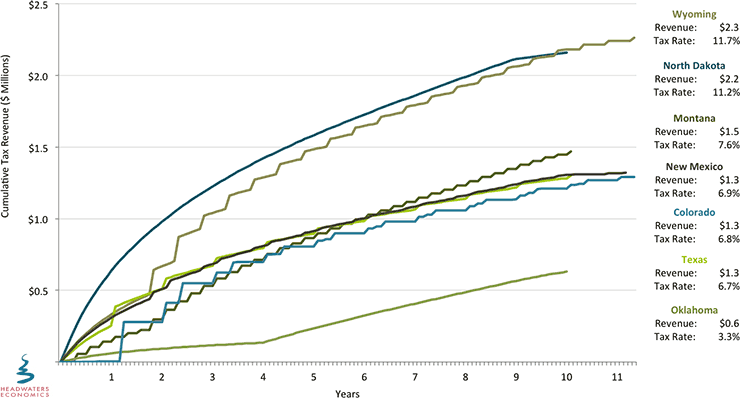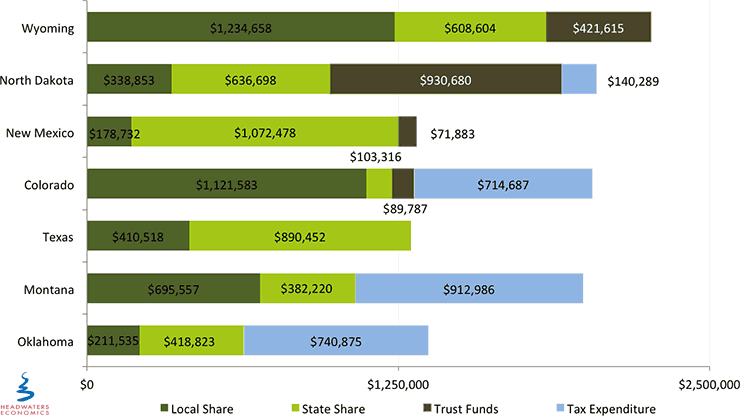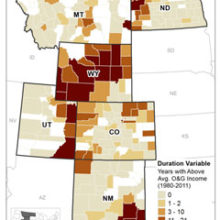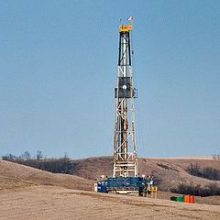Fiscal policy is important for local communities for several reasons. This analysis shows that many western communities are not receiving the resources necessary to manage impacts during the boom or to ensure resources are available after the boom. The Wyoming report is part of a larger series that looks at seven states: Colorado, Montana, New Mexico, North Dakota, Oklahoma, Texas, and Wyoming.
The focus on unconventional oil is important as horizontal drilling and hydraulic fracturing technologies have led a resurgence in oil production in the U.S. Unconventional oil plays require more wells to be drilled on a continuous basis to maintain production than comparable conventional oil fields. This expands potential employment, income, and tax benefits, but also heightens and extends public costs.
Mitigating the acute impacts associated with drilling activity and related population growth requires that revenue is available in the amount, time, and location necessary to build and maintain infrastructure and to provide services. In addition, managing volatility over time requires different fiscal strategies, including setting aside a portion of oil revenue in permanent funds.
Summary Findings
- Wyoming’s effective tax rate of 11.7 percent on unconventional oil production is the highest compared to the other six states in this report. The state levies two main taxes on oil production: a state severance tax and local property taxes. Wyoming does not offer any specific incentives for unconventional oil production (see Figure 1 below).
- Because local governments in Wyoming rely on property taxes to generate revenue from oil production, they are exposed to annual volatility and face challenges related to the timing and location of revenue collections that don’t necessarily match local needs.
- Wyoming saves a relatively large share of production tax revenue in a permanent trust fund, second only to North Dakota of the seven states we include in this report. The investment income is directed to the state’s General Fund.(see Figure 2 below).
Figure 1. Comparison of Production Tax Revenue Collected from a Typical Unconventional Oil Well

Figure 2. Comparison of Distribution of Production Tax Revenue from a Typical Unconventional Oil Well

Background
Unconventional oil is extracted from tight shale formations using horizontal drilling and hydraulic fracturing technologies. The focus on unconventional oil is important as horizontal drilling and hydraulic fracturing technologies have led a resurgence in oil production in the U.S. Unconventional oil plays require more wells to be drilled on a continuous basis to maintain production than comparable conventional oil fields. This expands potential employment, income, and tax benefits, but also heightens and extends impacts on communities and public costs.
State and local governments levy different types of production taxes, at different rates, and offer a complex array of exemptions, deductions, and incentives. The various approaches to taxing oil and natural gas make comparisons between states difficult, although not impossible. This report applies each state’s fiscal policy, including production taxes and revenue distributions, to a typical new unconventional oil well over ten years of production. This allows for a comparison of how states tax oil extracted using unconventional technologies, and how this revenue is distributed to communities over time.
To provide a simple framework for the comparison, we assess state production tax policies on four criteria: the amount, time, location, and predictability of revenue distributions to local governments where extraction and associated impacts occur. We also provide a summary of the methods and data used to compare state fiscal policies.
The various approaches to taxing oil make comparisons between states difficult, although not impossible. To compare states, we apply each state’s fiscal policy, including production taxes and revenue distributions, to a typical unconventional oil well. This allows for a comparison of how states tax oil extracted using unconventional technologies, and how this revenue is distributed to communities.
We hope these data and resources will be useful to states and communities with unconventional oil development that are trying to mitigate the short-term impacts of oil extraction while making investments in long-term economic development opportunities.




